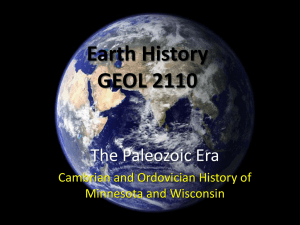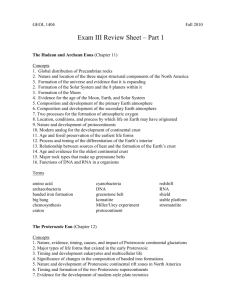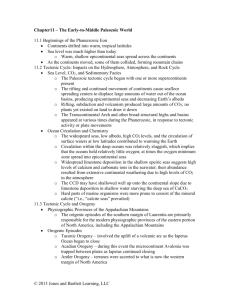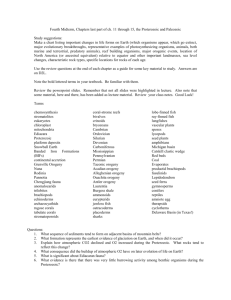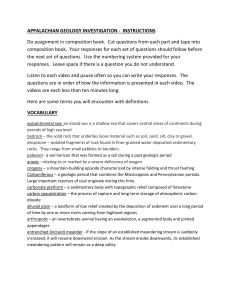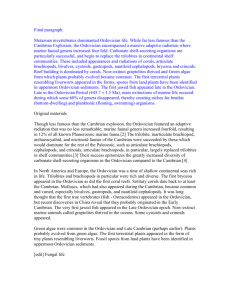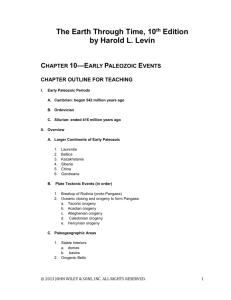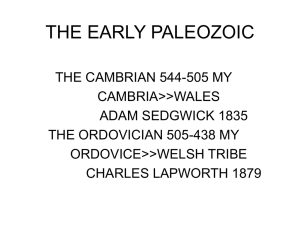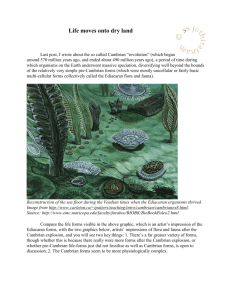thick latitude
advertisement
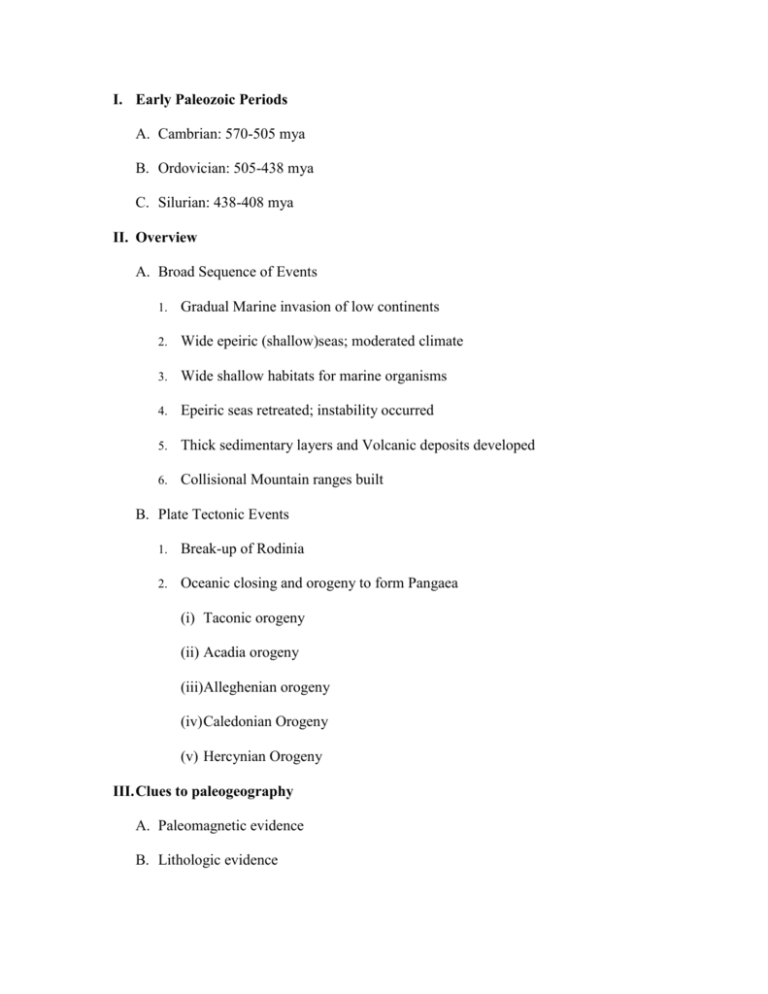
I. Early Paleozoic Periods A. Cambrian: 570-505 mya B. Ordovician: 505-438 mya C. Silurian: 438-408 mya II. Overview A. Broad Sequence of Events 1. Gradual Marine invasion of low continents 2. Wide epeiric (shallow)seas; moderated climate 3. Wide shallow habitats for marine organisms 4. Epeiric seas retreated; instability occurred 5. Thick sedimentary layers and Volcanic deposits developed 6. Collisional Mountain ranges built B. Plate Tectonic Events 1. Break-up of Rodinia 2. Oceanic closing and orogeny to form Pangaea (i) Taconic orogeny (ii) Acadia orogeny (iii)Alleghenian orogeny (iv) Caledonian Orogeny (v) Hercynian Orogeny III. Clues to paleogeography A. Paleomagnetic evidence B. Lithologic evidence 1. Limestone (shallow marine) 2. Evaporites (equatorial dry conditions) 3. Lithic Sandstone and greywacke (mountain uplift) 4. Arkose (arid conditions) 5. Tillites 6. Quartz sandstone 7. Shales IV. Laurentia (N. America) and Gondwanaland (first stage of Pangaea ) A. Gondwanaland 1. formed in southern hemisphere 2. consists of S. America, Africa, and other shields 3. Drifter south to polar position B. Laurentia 1. Lay on equator 2. rotated counter clockwise V. Continental framework A. Stable interior 1. Arches 2. Synclines 3. Basins 4. Domes B. Orogenic Belts 1. Cordilleran Mtn 2. Franklin Mtn 3. Appalachian Mtn 4. Caledonian mnt VI. Paleogeography of Laurentia A. Equator: North-central Mexico to Ellsmere Island, Canada B. Vast epeiric Sea (30o Latitude; vast carbonate deposits) C. Vast lowlands of Canada Shield were exposed (desert) D. Seaways 1. Appalachians (on east) 2. Cordilleran (on west) 3. Franklinian (on north) 4. Caledonian (on northwest) E. Extensive Sediment belts 1. Shales in seaways 2. limestone in empieric seas 3. Quartz sand on shoreline and deserts F. Volcanic Mountains: Texas and New England areas VII. Base of Cambrian A. Sedgwick’s original base (1835) 1. At top of nonconformity in Wales 2. At the first trilobite bearing fossiliferous beds 3. Later dated at 560 my B. New concept: Tommotian Stage (1970) 1. Base of Cambrian set at 570 my 2. New stage included fossiliferous rocks above Vendian and some fossiliferous rocks 3. Fossils in new stage: porifera, brachiopods, and organisms of unknown affinity VIII. Cratonic Sequence of Paleozoic 1. Sauk Sequence: Late Proterozoic to early Ordovician 2. Tippecanoe Sequence: Early Ordovician to early Devonian 3. Kaskakia Sequence: Early Devonian to end of Mississippian 4. Absaroka Sequence: Pennsylvanian to Early Jurassic IX. Early Paleozoic History A. Synopsis of Sauk Transgression 1. Canadian Shield eroded for 50 my prior to transgression 2. Gradual transgression covered shield 3. Transcontinental Arch (highlands) became island chain in shallow epeiric sea 4. Transcontinental Arch: Ontario to Mexico, parallel to Cambrian equator 5. Late Cambrian seas: MT to NY 6. Cordilleran deposits of Grand Canyon (i) Tapeat Sandstone (oldest) (ii) Bright Angel Shale (iii)Mauv Limestone (youngest) 7. Bright Angel Shale: good example of temporal transgression of facies (i) Early Cambrian (CA) (ii) Middle Cambrian (AZ) 8. Early Ordovician regression ended deposition (i) Vast continental-scale uncomformity (ii) Karst topography on carbonates rocks B. Synopsis of Tippecanoe Transgression 1. Initially vast Sandstone deposits covering hundreds of square miles (super mature sands, e.g., St Peter Sandstone) 2. Shallow Marine limestones with vast fauna (i) Brachiopods (ii) Bryozoans (iii)Echinoderms (iv) Mollusks (v) Corals (vi) Algae 3. Great organic reefs formed 4. Extensive shales in Queenston Clastic Wedge of Niagra Falls area 5. Landlocked, reef-fringed basins formed (i) Michigan Basin (Extensive evaporates) (ii) Appalachian Basin X. Cordilleran Region History A. Sauk Interval 1. Passive Margin on opening ocean; deep marine basin on west 2. Western ocean opened; block rotated out; included Siberian region of Asian continent 3. Arms of rift filled with thick sediments (i) Belt supergroup (MT, ID, BC) (ii) Uinta Series (UT) (iii)Pahrump Series (CA) (iv) Canadian Rockies (BC, Alberta) B. Tippecanoe Interval 1. Conversion to active margin with subduction (Wilson Cycle) 2. Volcanic Chain formed along western trench 3. Trench deposits; greywacke and volcanics 4. Western ocean deposits: Siliceous black shales and bedded cherts with graptolites (graptolite facies) 5. East of subduction zone: shelly facies- deposited in back arch basins (fossiliferous carbonates) XI. Appalachian History A. Appalachian Trough: Deformed three time during Paleozoic B. Subdivisions of trough: 1. Eastern sediment belt: greywacke, volcanic siliceous shale 2. Western sediment belt: Shale, sandstone, limestone C. Physiographic region of today 1. Eastern belt: Blue Ridge and Piedmont 2. Western Belt: Valley and Ridge and Plateau D. Sauk Interval 1. Trough was a passive margin on opening ocean (i) Shelf sediments: sandstone and limestone (ii) Oceanic sediments: shales 2. Transgression spread deposits westward across craton; thick carbonates formed on subsiding shelf 3. Abrupt end with onset of subduction and ocean closure during Middle Ordovician E. Tippecanoe Interval 1. Carbonate sedimentation ceased; platform downwarped by subduction 2. Thick graptolite black shale and shoreline immature sands spread west 3. Volcanic flows and pyroclastic beds formed when volcanoes emerged on coast 4. Rapid closing of eastern ocean (Iapetus); coastal and volcanic arc developed 5. Millerburg Volcanic ash bed formed (454 my; 1-2 m thick) 6. Taconic Orogeny occurred in three phases (i) Appalachian Mountains built in collision with part of western Europ (ii) Compression folded shelf sediments into mnt and Logan’s Thrust formed (48 km displacement) 7. Giant granitic batholiths produced by Taconic melting 8. Taconic Mountains weathered to form vast sandstones of PA, WY, OH, and NY 9. Great clastic wedges spread westward (age tracts deformation) (i) Middle Ordovician (southern Appalachian) (ii) Late Ordovician-early Silurian (Northern Appalachian, Queenston Clastic Wedge) 10. Clinton Iron-ore deposited in southern Appalachian region near end of interval 11. Development of Ouachita-Marathon trough; connects Appalachian and Cordilleran troughs (greywackes, shales, siliceous sediments) XII. Caledonian History A. Geographic Extent: Scotland and Northwest Scandinavia B. Trans-Atlantic Continuation of Appalachian Mtns C. Tectonic History of Wilson Cycle 1. Opening: Late Proterozoic to Middle Ordovician 2. Closing: Middle Ordovician to Early Devonian D. Iapetus Ocean (Opening phase) 1. Between Laurentia and Baltic (Europe) 2. Three main facies (i) Graphtolite-facies; volcanics, greywackes, shale (ii) Shelly facies: Mature sandstone and fossiliferous limestones (iii)Eurypterid facies: shales with terrestrial arthropods E. Closing Phase of Iapetus 1. Caledonian Orogeny was result 2. Volcanic Beds: NW England, Greenland, Norway 3. Climax of Orogeny: Late Silurian to Early Devonian (i) Norway-most intensive deformation (ii) England- least intensive effects 4. Old Red Sandstone: Clastic Wedge deposited south and east of Caledonian Mountains (area known as “Old Red Continent”) 5. Old Red Sandstone; analogue of Queenston Clastic Wedge 6. Greenland-Spitbergen sequence: shows stratigraphy of Iapetus Documenting Wilson Cycle XIII. Ural Seaway History A. Initial Seaway Seperation: Russian platform (west) from Angaran shield (east) B. Russian Platform Stratigraphy: Shelf carbonates, sandstone, shales (thinning toward interior) C. Angaran Shield Stratigraphy: Deep marine trough turbidites, shales, volcanics D. Wilson Cycle 1. Opening Phase: Early Cambrian to Late Silurian 2. Closing Phase: Silurian/Devonian to late Permian E. Age of Volcanics, Mafic Intrusions, and Folding (all related to closing phase) XIV. Asian Continental History A. Encompasses nine micro-continents (with narrow seaways- like Uralian Seawaybetween them) B. Seaways began their closing phase during the Early Paleozoic C. Asia assemblage of continents completed during the late Paleozoic D. Charaacteristics of Asia Orogenic Belts 1. Narrow Zones of high-pressure metamorphism 2. Ophiolite Zones E. Final Phases of deformation: continued into Triassic XV. African History: middle to late Ordovician A. Middle Ordovician: Africa “upside-down” relative to orientation today; located near S. Pole, moving South B. Late Ordovician: S. Polar ice cap covers 1000km2 (is now Sahara Desert) C. Evidence of Glaciation 1. Glacial Striations on Archean granitic and Cambrian sandstone 2. Tillites 3. Outwash, moraine, meltwater channel deposits over 100km2 on shield rocks XVI. Australian Continental History A. Rocks of Tasman Trough: Late Proterozoic to Ordovician 1. Mature Sandstone (oldest): Stability 2. Greywacke and Volcanics: instability 3. Sorted sandstone and limestone (younger): Stability B. Tasman Trough (Connected laterally to others) 1. Andean trough of western S. America 2. Cape trough of South Africa 3. Transarctic trough of Antarctica 4. New Zealand trough XVII. Climates A. Transgressions= Mild Climates, windswept low terrains B. Regressions and Orogenic Episodes= Harsher more diverse climates; winds diverted by mountains C. Earth Rotation was faster (shorter days, greater tidal effects) D. No land Plants 1. Solar Radiation reflected, not absorbed 2. Sever temperature differences resulting E. Rapid Changes in Solar Energy Output: Temperature effect dramatic F. End of Late Proterozoic Glacial Cycle: Cool beginning for Early Paleozoic G. Melting Polar Caps= Rising sea levels and warming H. Equitorial Position= tropical climates for Laurentia, Baltica, and Antarctica I. No Ice caps= warm polar seas J. Ordovician Reefs (flourished +- 30o latitude) K. Cross Bedding in Desert Sand Deposits (shows wind blew NE to SW across eastern Laurentia- opposite of today L. Silurian Temperature Zonation 1. Glacial deposits above 65o latitude 2. Reefs, evaporates, eolian sands below 40o latitude M. Ordovician Sea Levels and Biotic Extinctions 1. African Glaciation lowered sea levels and cooled global temperatures 2. End-Ordovician extinctions in many families (i) Bryozoans (ii) Tabulate corals (iii)Brachiopods (iv) Sponges (v) Nautiloid cephalopods (vi) Crinoids 3. Specific physical effects (i) Loss of epeiric sea areas (ii) Lower sea levels (iii)Erosion of vast areas (iv) Cooling tropical seas XVIII. Early Paleozoic Paleogeography A. Late Cambrian 1. Major land areas at low latitude 2. well-connected global ocean 3. main continents (i) Kazakhstania (east asia and northern Iran) (ii) Siberia (iii)Baltica (iv) Laurentia (v) Gondwanaland (vi) No land areas N or S of 60o polar oceans B. Ordovician-Silurian 1. Major shift of Gondwanaland to south polar position 2. Baltica circled and moved toward Luarentia (Started closing Iapetus)
